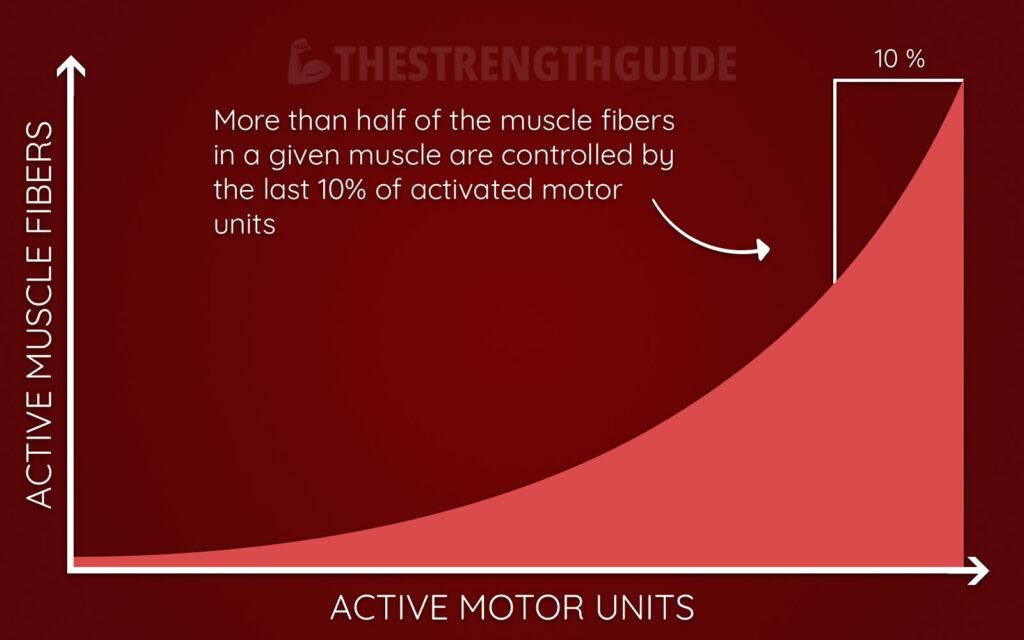You are now reading part 2 of the comprehensive strength training guide that teaches you the A - Z of building muscle and strength through articles that are easy to understand. Click here to see all the articles in the guide.
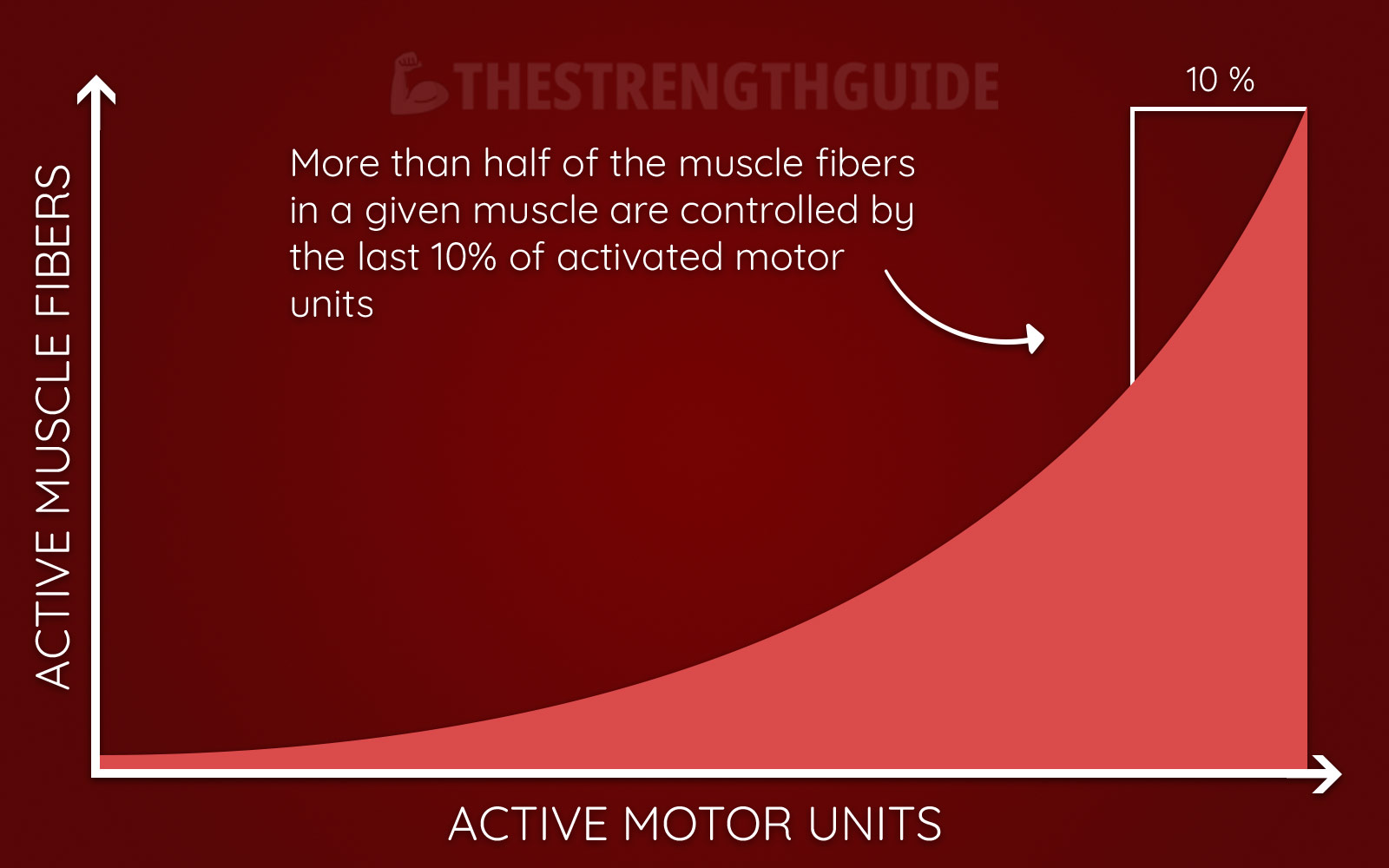
You should know a bit about how your muscles are structured if you want to train efficiently or build muscle as quickly as possible.
A car mechanic would not have been able to repair your car without a good understanding of how it is put together. He could have tried many different things without success. Maybe he could replace a few parts and grease some bearings in the hope that the defect would be resolved.
What he’s doing is shooting in the dark. So are you if you don’t have a good understanding of why you do what you do when you train for strength and muscle growth.
Do you take all the movements to a full range of motion or just selected ones? How heavy should you lift? Which exercises are best? How many reps and sets, and how long should the breaks be?
You need to understand your muscles to be able to answer these questions, and that’s why you should care just a little bit about muscle physiology.
After reading this article, unlike our mechanic friend, you will no longer be shooting in the dark.
Let’s go through how muscles are structured.
Below the surface of the muscle
Imagine you are doing a biceps curl. What happens in the biceps when you lift the weight? If you look closely, it contracts. It goes from being long and thin to short and thick.
I remember when my dad and I compared biceps muscles when I was little. Dad had a potato muscle. I just had a carrot muscle.
When the biceps go from carrot to potato – when they contract – your arm flexes. The bone in the forearm moves towards the bone in the upper arm.
This movement is called “flexion” in biomechanical lingo.
But what actually happens inside the muscle when it contracts?
It’s easy to think of the muscle as a big, fat rubber band that can contract on demand.
I think that’s a useful analogy, but it’s not quite right. You see, your muscles are made up of thousands of so-called muscle fibers. It’s these individual muscle fibers that together bend the elbow or lift the weight.
Therefore, it is better to look at your muscles as a collection of thousands of small rubber bands, or small mini-muscles, that do the work.
Your muscles consist of both type 1 muscle fibers and type 2 muscle fibers.
Type 1 fibers are weak, slow, and very enduring, while type 2 muscle fibers are very strong and fast.
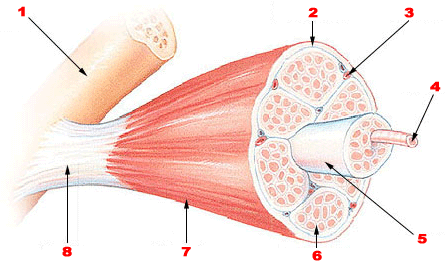
Inside the muscle fibers, you have something called myosin and actin filaments. Relax, we won’t go too much into the physiology here. Just think of myosin as hooks and actin as attachment points.
When a muscle fiber contracts, the hooks will pull on the attachment points. When you relax, they let go.
You may have noticed that you don’t walk around like a crazed psychopath who has just escaped from the psychiatric ward. Why is that? Why don’t our muscles contract completely randomly all the time?
Let’s go back to the car mechanic example again. Think of the car this mechanic was trying to fix. It has an accelerator pedal connected to the engine. When the accelerator pedal is depressed, the engine will start to give power to the wheels.
Much the same thing happens in your muscles.
You can think of your nervous system as the accelerator pedal. The nervous system determines how much power your muscles are to exert. The signals that control this come from the brain.
If you have to lift something very heavy, the signals coming from the brain will be very strong.
However, if you are holding a newborn baby, it makes sense not to press the accelerator pedal all the way down.
However, your muscles are not exactly like a car engine.
You may recall that I mentioned that you have several thousand muscle fibers. What’s special about them is that they don’t have any way to apply just a little bit of force. Either the muscle fibers are on, or they’re off.
You get, quite simply, either maximum force out of a single muscle fiber, or nothing at all.
Then how can you possibly manage not to squash a newborn baby if it’s actually the case that your muscle is either providing maximum force or being limp as a noodle?
That’s actually a pretty good question!
It’s not your muscle that’s either off or on, but the individual muscle fibers.
Since your muscle consists of thousands of these muscle fibers, it is quite possible for your nervous system to activate just some of them.
If only 20% of the muscle fibers are activated, the muscle will not exert maximum force.
How are the muscle fibers inside the muscle controlled?
Let’s take a step back so that you can get a better understanding of how the thousands of muscle fibers in your muscles are actually controlled.
I completely understand if you think physiology is a bit boring. Try to focus just a little bit longer. We’ll use this knowledge later in the guide to figure out exactly how we can train to get the muscles to respond in the best possible way.
Your brain sends out a signal for the muscle to contract. The signal goes through the nervous system and down to the muscle.
But how does the muscle “know” to do anything? How does the nervous system talk to the muscle?
Do you remember that your individual muscle fibers are either on or off? That there is no in-between?
It’s the same with your TV. Either it’s on or it’s off.
You control this with a button on the remote control. Your muscle fibers also have a button like that. This is called a “motor unit”.
When the signal from the brain arrives, the nervous system presses the button to turn on the muscle fibers. The nervous system activates the motor unit, and the muscle fibers are “switched on”.
However, it is not as simple as each muscle fiber having its own button. In fact, a single button can control anything from a few to over a thousand muscle fibers.
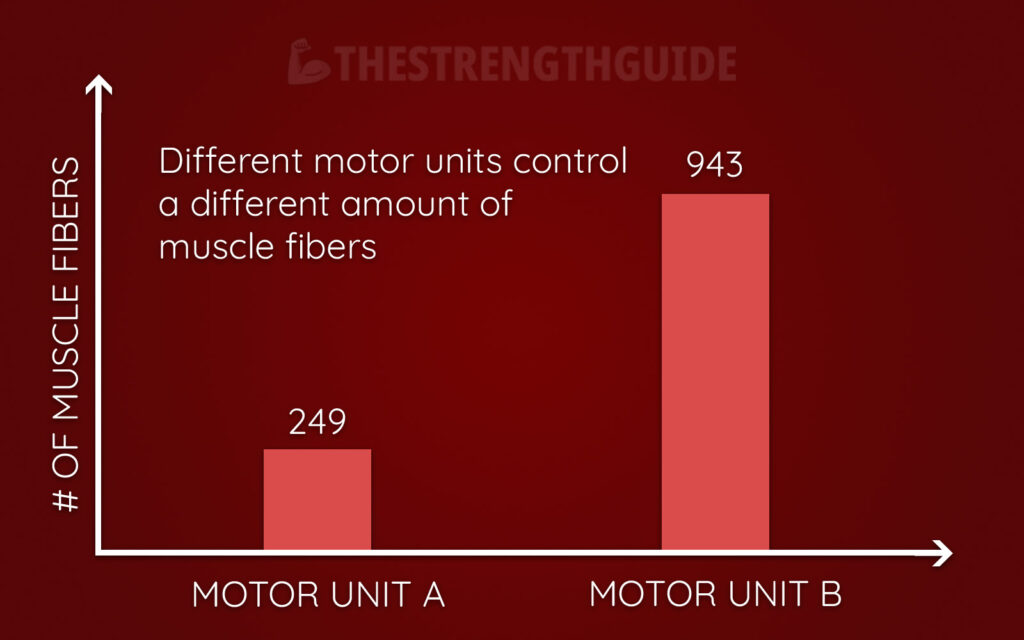
You can imagine yourself standing with a remote control in the TV department of a large electronics store. Press the “ON” button, and all the TVs that are of the same brand as the remote control turn on. The other TVs don’t respond.
The same thing happens in your muscle. Only the muscle fibers connected to the motor unit receiving the signal from the nervous system will start to contract.
You may now be looking at the screen with one of your eyebrows slightly raised. Perhaps you’re wondering how the body decides which motor unit to turn on.
You probably remember that you have both slow type 1 fibers and fast and strong type 2 fibers. How does your body know which ones to activate, and when?
Muscle fibers are activated according to a given system
What’s a bit exciting is that the body activates your motor units according to a certain system. This system is called “Hennemann’s size principle“.
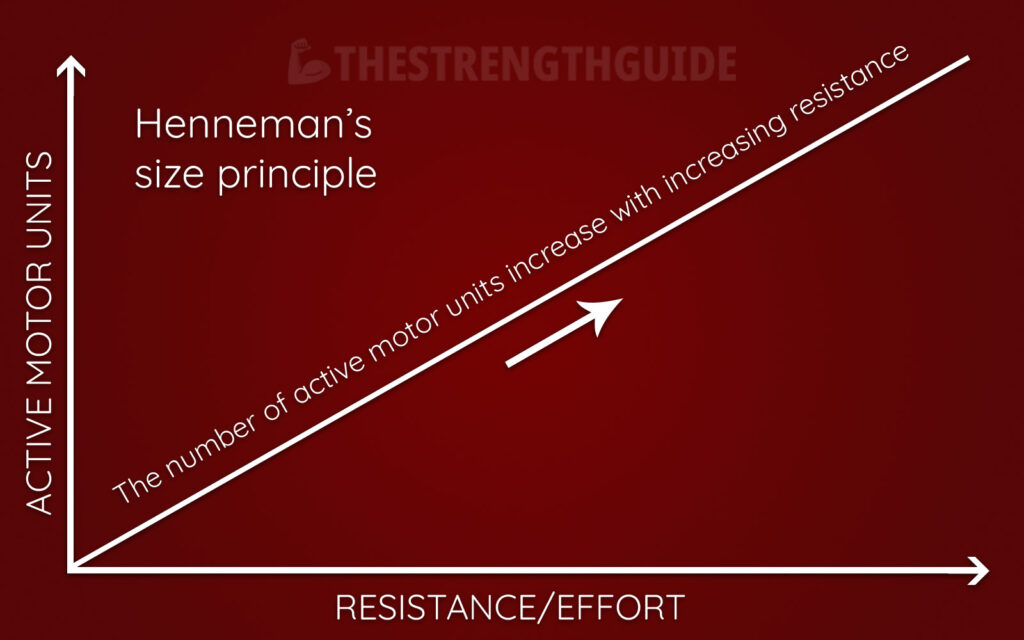
There are motor units that are easy to activate, in addition to motor units that are harder to activate. The motor units that are easy to activate largely control type 1 muscle fibers that are enduring.
The motor units that are hard to activate also control some type 1 fibers, but are largely linked to type 2 fibers that are strong and explosive.
The muscle fibers associated with the motor units that are easy to activate do not grow very much after strength training. This is because they have already reached their maximum size since they are activated by normal daily activities.
The exciting thing is what happens to the muscle fibers associated with motor units that are difficult to activate. These grow very well when they are trained properly. The reason they grow so much after strength training is that normal daily activities do not place any great demands on these muscle fibers.
They, therefore, have a lot of untapped potential!
Here’s something important:
Most of your muscle fibers are attached to motor units that are hard to activate. In fact, more than half of your muscle fibers are attached to the last 10% of activated motor units.
This means that you are only using half of your muscle if you manage to activate 90% of the motor units in that muscle.
Back to Hennemann’s size principle: Your body is super smart. It doesn’t want to spend energy on things if it doesn’t have to.
That’s why the motor units that largely control the slower and weaker type 1 muscle fibers are activated first. If the weight doesn’t move, more signals are sent so that more motor units are activated.
If you exert more effort, then more motor units are activated. After a while, the stronger type 2 fibers also join the party.
This is quite important!
As you can probably figure out, only the muscle fibers that are activated will grow after strength training.
As you exert more and more effort, you put greater demands on your muscles. This “greater demand” leads to increased activation of motor units that also control muscle fibers that have a great potential to grow and become stronger.
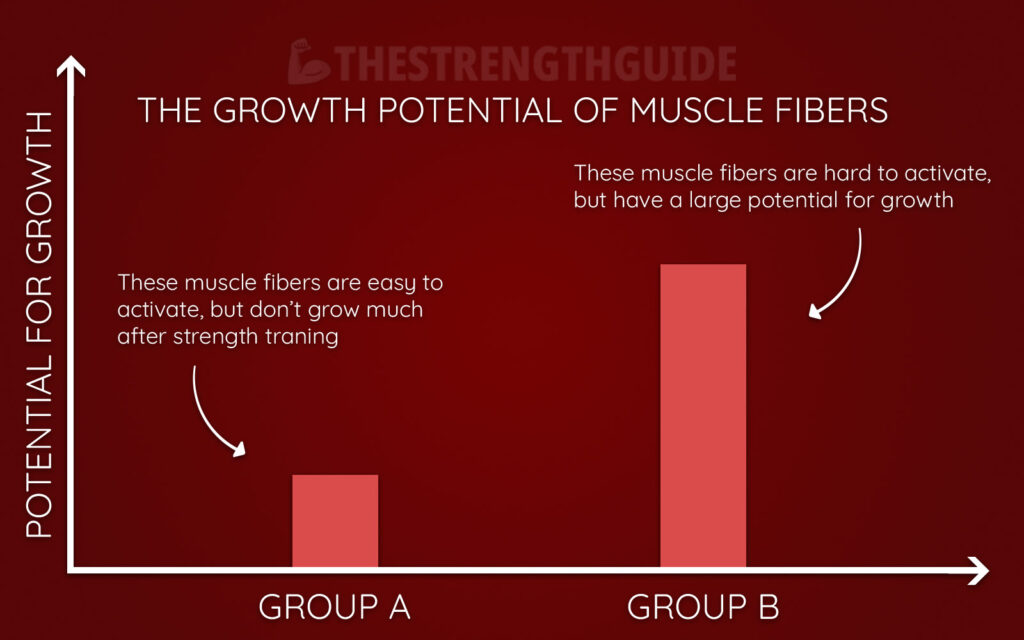
That’s why you can often read that you have to lift heavy to get results from strength training.
But what exactly is “heavy”, and when do you know that all your muscle fibers are activated? After all, you want the whole muscle to get bigger and stronger after strength training, not just a small part of it.
How heavy should you lift to activate all muscle fibers in a muscle?
It is widely agreed that all the motor units you are able to activate, and therefore all the muscle fibers associated with them, are switched on when you are lifting at 80-90% of your maximum effort or more.
It has also been found that not all muscles reach full activation at the same time. Some muscles reach full activation as early as 30-50% of maximum effort.
There are also differences between muscles when it comes to the level of activation we can achieve just by using our own willpower.
Researchers have found that more muscle fibers are activated by sending an electrical current through the muscles than when you exert maximum effort yourself.
That’s how we know that you can’t activate all the motor units in a given muscle by yourself. The proportion of motor units you can activate varies between muscles.
“Full activation” often refers to so-called “voluntary activation”, i.e. when you have reached the maximum activation the muscle can achieve with signals from the brain.
For example, we can activate a very large part of the biceps muscles when we exercise. The situation is another when it comes to the quadriceps muscles at the front of your thigh, where about 15% of the muscle is inactive even at maximum effort.
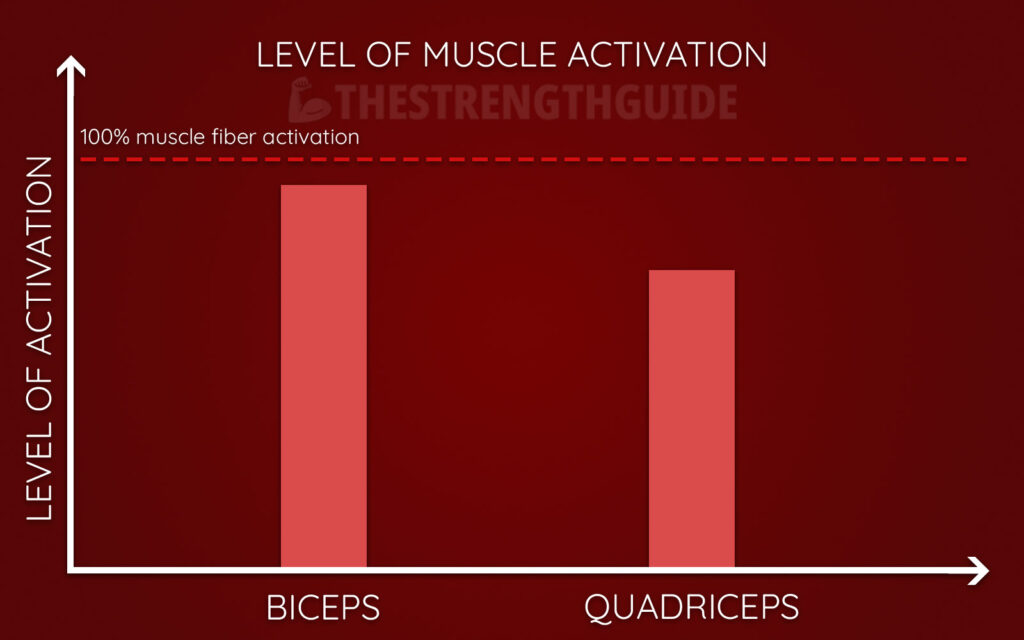
This is important because it will affect how easily we get muscle damage in the trained muscle after strength training. Later in the guide, we will go through important aspects to consider related to the activation level at maximum effort.
We call your maximum effort your 1RM (1 Repetition Maximum), which is the weight you can only lift once in an exercise, but which you cannot lift twice.
As people at the gym say: “How much do you bench? What’s your max?”. They’re asking for your 1RM in the bench press.
In simple terms, if you can lift 100 kg in the bench press once, lifting 80 – 90 kg will use all the muscle fibers from the first repetition.
This is where the idea that you have to lift heavy comes from. After all, you can only do 8-10 reps when you’re lifting 80% of your 1RM. That’s pretty heavy.
Observant readers might wonder how we are able to lift 100 kg once if all muscle fibers are activated at about 80 kg, and every muscle fiber is either off or on.
Shouldn’t you only be able to lift 80 kg if the muscle fibers are either exerting maximum force or are completely inactive? This is where it gets a bit complicated.
We also have something called firing rate which helps to control power after we have reached full activation. Fortunately, you don’t need to understand this to understand how strength training works.
However, it’s not like you have to lift over 80% of your 1RM in an exercise to stimulate muscle growth.
In fact, a whole range of repetitions per set can work very well. We’ll look at why this is the case in an article later in this guide.
Right now, we should take a quick recap to make sure you remember how your muscles are structured and how they work.
Summary of how your muscles work
Muscles are made up of thousands of tiny muscle fibers. We have type-1 and type-2 fibers. Type-1 fibers are slow, weak, and enduring. Type-2 fibers, on the other hand, are fast, explosive, and strong.
Each muscle fiber is connected to a motor unit, and many thousands of muscle fibers can share the same motor unit. When the brain sends a signal to the muscles via the nervous system, the motor unit is switched on.
This activates all the muscle fibers attached to this motor unit. Only the muscle fibers that are activated will grow after exercise. The muscle fibers that are most difficult to activate grow the most.
More than half of the muscle fibers in a muscle are associated with the 10% of motor units that are the hardest to activate. You need to reach these fibers to get the best effect from strength training.
A muscle fiber is either off or on. The force the muscle exerts is determined by how many muscle fibers are turned on. When you lift a weight of about 80-90% of your 1RM, you will activate all the motor units that you are able to activate by your own willpower.
However, this does not mean that you need to lift that heavily to activate all the muscle fibers, something you will learn more about later in this guide.

 by
by 